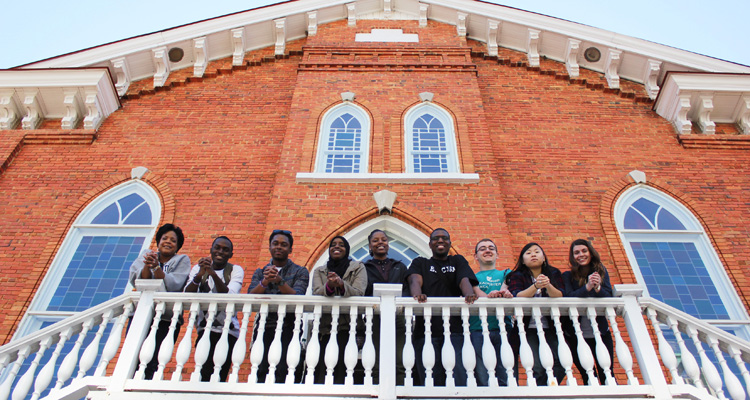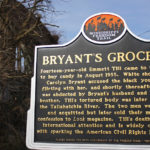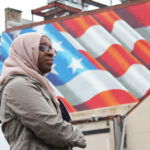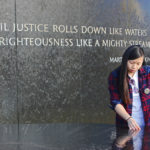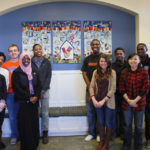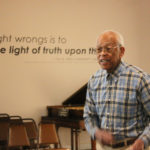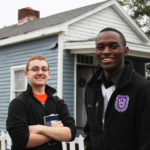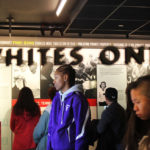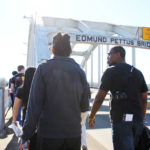On May 17, 1954 the Supreme Court of the United States decided on the landmark case Brown vs. Board of Education, declaring segregation in public schools unconstitutional. Chief Justice Earl Warren delivered the court's opinion, stating that "in the field of public education the doctrine of 'separate but equal' has no place."
For three years, the Excel! Research Scholars Program (formerly the McNair Scholars Program) at St. Thomas has taken small groups of Excel! Research Scholars on a two-week study tour of the American Civil Rights Movement called "Journey for Justice." Students immerse themselves in the American Civil Rights Movement (1955-1968), meeting people who served on the front lines and made giant leaps forward in racial equality – not unlike the Brown ruling – possible.
"It's a study tour, not site-seeing," said Excel! Program Director Cynthia Fraction. "But it's also a very moving trip, so while it's an academic experience (students are required to write a scholarly, research-based piece on something they learned on the trip), it's also very emotional and personal."
The program's approach is akin to a pilgrimage – "a long journey, especially one undertaken as a quest or one for a votive purpose, as to pay homage." This year six Excel! students (Anisa Abdulkadir, Raymond Nkwain Kindva, Quinmill Lei, Tyler Skluzacek, Tiana Daniels and James Mite); Courtney Crowley, the program's graduate assistant and writing specialist; and three St. Thomas staff, including Fraction, Teron Buford (Undergraduate Admissions) and Katie Hubly (Grants and Research) – began their travels with a 700-mile flight from Minneapolis to Memphis. The real journey, however, took place during the tri-state tour that took the group by bus from Memphis to Mississippi – Oxford, the Delta, Jackson and Canton – followed by a sojourn through Alabama – Birmingham, Selma and Montgomery – before concluding in Atlanta, where they toured the Center for Civil and Human Rights.
Every year the schedule is rigorous, with many days beginning between 6:30 and 7:30 a.m. Each day's itinerary lasts roughly eight to 10 hours and is rich with back-to-back site and college visits, and intimate meetings with "foot soldiers," people who served on the front lines of the Civil Rights Movement.
For senior biology major Abdulkadir, the group's conversation with foot soldier Flonzie Brown-Wright in Canton, Mississippi, was the most memorable portion of the trip. In 1968 Brown-Wright became the first black woman to hold office in Mississippi after she was elected election commissioner for Madison County – a role that had her setting up and monitoring elections that just a few years earlier she couldn't take part in.
"It was the most inspirational and heartfelt part of the trip for me," Abdulkadir said. "I realized most strongly there that we are all standing on the shoulders of those who fought and died for civil rights ... how I wouldn't be able to vote, attend an integrated university or live a life of opportunity and equal rights if it weren't for the efforts of these foot soldiers."
"Could you do what they did?"
Between visits to historic sites – including, among many others, the National Civil Rights Museum-Lorraine Motel, Medgar Evers' home and museums in honor of Emmett Till and B.B. King – the travelers immersed themselves in the Civil Rights Movement by reenacting monumental events and experiences that shaped American history, like the marching across the Edmund Pettus Bridge in Selma, Alabama, and boarding a (simulated) segregated bus in Montgomery, Alabama.
Fraction said she often would challenge the students during these forays by asking, "Would you, could you do what they did?"
Senior Nkwain Kindva took Fraction's question to heart when the group walked arm in arm across the Edmund Pettus bridge and reenacted the beginning of the historic 1965 march to the capital in Montgomery. The five-day, 54-mile march led by Martin Luther King, Jr. was instrumental in hastening the enactment of the Voting Rights Act later that year.
"We saw the movie 'Selma' the night before. There was a scene where a man asks John Lewis, while they both are crossing the bridge, if he knew how to swim ... because the marchers knew they would be attacked, and there was a very good possibility that their only means of escape would be to jump into the river," Nkwain Kindva said. "It was very eerie for me. I couldn't help but look down and wonder, 'Would I survive if I were thrown in or had to jump?' It was mind blowing. I can't imagine what it might've felt like to know you might not live to see the next day."
The power of service
Fraction chose "service" as the theme for this year's trip. The meaning was twofold. The group served in the traditional sense, volunteering at the Ronald McDonald House in Birmingham, collecting toiletries from their hotels to donate to the Harriet Tubman Center in south Minneapolis and donating three backpacks to school children in Canton, Mississippi. Working in pairs, each student collected school supplies and civil rights-related items for the school children. They presented them to a panel of town leaders – including the mayor of Canton, Mississippi, Arnel Bolden, and a handful of foot soldiers – along with what they learned during their trip and how they hoped to evoke change in civil rights.
The significance of the foot soldiers' service – the act of giving a part of oneself to help another – as the backbone of the civil rights movement also served as the lens through which the students viewed history and was another, deeper side to the service theme.
"It will always be my goal for Journey for Justice to show show how programs like Excel! didn't just happen out of thin air. The opportunities we have today are here because there were people who fought so hard. Some of those people lived. Some of them died," Fraction said. "One thing we learn on the trip is that, for the most part, life was secondary to the movement [for the foot soldiers]. And because of their fight, their service, there's a lot of us who now have the chance to go to school, to have financial aid that supports our education."
Fraction and David Steele, director of the Grants and Research Office, noted the strong connection between the Excel! program's mission and how the success of the civil rights movement was built on the leadership of educated men and women.
Fraction cited, in particular, the NAACP, Martin Luther King Jr. (who completed his Ph.D. at 26) and members of the Student Nonviolent Coordinating Committee, like John Lewis and Bob Moses, as instrumental to the movement for their push to employ strategic, nonviolent methods of "fighting."
"Journey for Justice was never all about, 'Oh, look how horrible it was for them.' It's looking at what they did to win," she said. "My goal is to sharpen students by studying the strategies of the movement. Those leaders who paved the way for equality knew that you needed to get an education so your critical thinking skills are solid."
“I’ve seen the lives of our students quite literally transformed through this program. Along the way, they meet truly extraordinary individuals who risked their lives for justice and freedom – people who were on the front lines of history," Steele said. "Throughout the trip, you can see how the students become more and more inspired by the realization that it is now their turn to step up and advocate for change. It’s really exciting to watch!”
Making an Impact
A common reflection students had upon their return was how strong an impact the trip had on their world views, how America is not yet a post-racial society and how the experience fortified their resolve to be agents of change.
"The most impactful thing I learned about the civil rights movement is that it is nowhere near over. As long as their is racial injustice ... there still is work to be done," said Lei, a junior psychology major on the trip. "If not us, who?"
Crowley, who also took part in last year's trip as a graduate assistant, noted that the study tour deepened her understanding of the Civil Rights Movement in a way that no history book ever could. “Journey for Justice taught me to continue the conversation about racial injustice in America. We have made significant progress since the civil rights movement, but still have a long way to go. By critically examining our nation’s history and embracing our role as 21st century change agents, we can move our country forward," she said.
Unlike in past years, Fraction plans to change up the itinerary in 2016, beginning with a look at the plantations of South Carolina, followed by a stop in Savannah, Georgia, then backtracking along the trip's usual route of civil rights stops before departing from Memphis. Students will receive the same unique and history-drenched experience as in previous years," she said.
"It's indispensable the things students learn on this trip," Fraction added. "Things that aren't taught in your typical classroom."
For a closer look at Journey for Justice, visit the Grants and Research Office, where journals of the 2014 and 2015 students' research papers on the trip are available.
